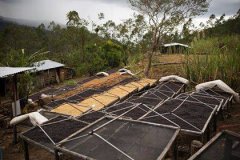The relationship between altitude and coffee flavor, why the coffee flavor in high-altitude coffee producing areas
The tropical region between the Tropic of Cancer and Tropic of Cancer produces the world's truly high-quality Arabica coffee in Central and South America, South Asia and some Pacific islands, central and southern Africa is also the most important coffee growing area in the world. 3000-6000 feet (2000 meters) high altitude provides ideal conditions for coffee growth: an average frost-free climate of 60-70 degrees Fahrenheit (15-21) throughout the year and about 80 inches of moderate rainfall In addition, the coffee beans in the mountains with abundant sunshine and lower temperatures grow more slowly, and the slow ripening process makes the coffee beans have higher sugar content, more interesting flavor, higher displacement at higher elevations, and more concentrated fruit flavors. the best Arabica coffee-growing areas have very fertile soil and are often in volcanic areas.
Coffee beans grown at high elevations are hard, dense, and have the potential to give play to a special flavor. the really amazing coffee growing areas are at high altitude. these beans are picked carefully only in the mature season, generally with the increase in altitude. The aroma of coffee will become increasingly prominent and unique (see figure) from the temperature and sweetness of Brazilian beans at a low altitude of 3500 feet to a surge in the taste of Ethiopian coffee beans above 6000 feet. Altitude will give coffee beans a more complex and subtle taste.
The rating of Central American coffee is based on the altitude at which the coffee grows. Mexico, Honduras, Haiti and other countries are rated at a high level.
Strictly High Grown (SHG), followed by High Grown (HG)
Mexico is called Altura, which means high in Spanish, indicating that it is high-altitude coffee; Papua New Guinea adds the name "Mile High" to mark coffee beans grown in the highlands and mountains.
On the other hand, in the alpine area, due to the cold climate, the coffee grows slowly, the density of raw beans is higher, the texture is harder, the more mellow and aromatic the coffee is, and it has a supple sour taste; on the other hand, in lower areas, the density of raw beans is smaller and the texture is less hard, the worse the quality of coffee is, so some people grade it by hardness.
Guatemala, Nicaragua, El Salvador, Costa Rica and other countries are classified as follows:
Grade growth height grade abbreviation
Strictly Hard Bean
(extremely hard beans) about 1372 to 1524m SHB
Good Hard Bean
(high hard bean) about 91401372m GHB
Hard Bean (hard bean) is about 610-914m HB
Pacific
(Pacific coastal area) about 300m to 1000m Pacific
Practice shows that the effect of altitude on quality has exceeded the effect of genotype on quality, and Viagra personally thinks that the classification of coffee beans based on altitude is more scientific and reasonable than simply grading by size and defect rate. because to a certain extent, altitude classification is indirectly graded by taste, the beans with low altitude grow fast and large, and the defect rate can be changed by selection, but altitude can not be changed.
Why do coffee beans taste better in high altitude areas?
1. Rich in nutrients
Less chlorogenic acid
Because if the coffee bean growth environment is bad, such as insect pests, high temperature, dry, the body of coffee beans will summon the chlorogenic acid shrew army to protect themselves. Relatively low altitude, high altitude undoubtedly provides an ideal growth environment, so chlorogenic acid is relatively less.
Rich in tannins
The study found that coffee grown in high-altitude areas has richer tannins than acid, which makes good coffee taste like tea rather than a mouthful of lemon and vinegar.
Therefore, many coffee merchants will use "high altitude" to shout for the quality of coffee beans, while many producing areas will use the altitude at which coffee beans grow as the basis for the quality of coffee beans.
High sucrose content
Sucrose content is proportional to altitude, and sucrose content is proportional to the taste of our coffee. Although it is called sugar, it is not a sweet candy. Sucrose in coffee roasting, will produce a lot of aromatic substances, release caramel, forming a unique strong aroma of coffee. Coincidentally, tea also contains a lot of aromatic substances.

Important Notice :
前街咖啡 FrontStreet Coffee has moved to new addredd:
FrontStreet Coffee Address: 315,Donghua East Road,GuangZhou
Tel:020 38364473
- Prev

The characteristics of Brazilian coffee beans, how to bake Brazilian coffee beans? Brazilian coffee bean baking curve
Professional coffee knowledge exchange more coffee bean information please follow the coffee workshop (Wechat official account cafe_style) Brazil has always been the country with the largest production of coffee beans, with a total annual output of about 2.7 million metric tons, accounting for 1/3 of the world's total coffee bean production (you can see that we drink a lot of coffee in a year) Brazil's coffee beans are concentrated in the central and southern parts of the country, and the planting areas are common.
- Next

Brewing parameters of Black Honey Coffee beans in Stonehenge Manor is it good to drink black coffee ice or hot?
Yesterday I just introduced the basic information of Stonehenge Manor Black Honey beans in Costa rica. today, many friends asked whether the hot taste of this bean is consistent with that of ice drink. Is it suitable to be a cold bubble or ice drop? Seeing that everyone was so enthusiastic about [Stonehenge Manor Black Honey], the editor went back to the store and immediately soaked a cup of cold soaked black honey. Let's try it tonight.
Related
- Detailed explanation of Jadeite planting Land in Panamanian Jadeite Manor introduction to the grading system of Jadeite competitive bidding, Red bid, Green bid and Rose Summer
- Story of Coffee planting in Brenka region of Costa Rica Stonehenge Manor anaerobic heavy honey treatment of flavor mouth
- What's on the barrel of Blue Mountain Coffee beans?
- Can American coffee also pull flowers? How to use hot American style to pull out a good-looking pattern?
- Can you make a cold extract with coffee beans? What is the right proportion for cold-extracted coffee formula?
- Indonesian PWN Gold Mandrine Coffee Origin Features Flavor How to Chong? Mandolin coffee is American.
- A brief introduction to the flavor characteristics of Brazilian yellow bourbon coffee beans
- What is the effect of different water quality on the flavor of cold-extracted coffee? What kind of water is best for brewing coffee?
- Why do you think of Rose Summer whenever you mention Panamanian coffee?
- Introduction to the characteristics of authentic blue mountain coffee bean producing areas? What is the CIB Coffee Authority in Jamaica?

